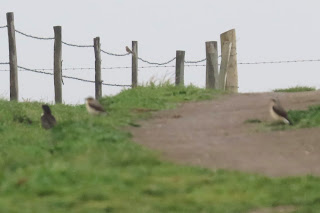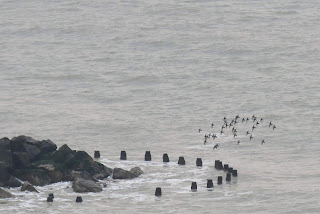The previous blog was written as I ate lunch, assuming my birding was done for the day, and I'd be soon off to work.
But then the rain set in, got quite heavy, and, well, I don't much like going to work at the best of times, and definitely not in the rain, and don't need much of an excuse to not bother these days! And thankfully, being self employed, I can be very flexible and the rain is a nice handy get-out. So, a couple of phone calls later, work rearranged for Friday, when the weather will be less birding friendly, and I was on my way back to patch, convinced that the rain would have dropped stuff in.
And just for once I wasn't disappointed!
Just past Becton Bunny there was a group of four Wheatears, clearly different to those this morning.
And then as I passed the end of the golf course, to the west of Taddiford Gap, things got a bit mental. Most intriguing was a feeding flock of about 400 Starlings
It's been nearly a month since the regular wintering flock dispersed, and that flock included a very distinctive leucistic bird. This flock didn't, and was presumably a migrant flock grounded by the rain. Observations like this are one of the real bonuses of working a patch: any casual visit would just reveal a flock of starlings, regular visits give that flock a little bit of context.
Very soon after this, however, the starlings were forgotten, as the day's best bird by far appeared on the clifftop path.
Bumping into Ring Ouzels away from their regular stop offs is an unpredictable business, and not something I've done often. In fact, this was only my second patch record, the first having been one of the most serendipitous sightings I've had: one October day back in 2010 I enjoyed one of my best ever autumn vismig sessions. With alba wagtail numbers in excess of 900 I decided I just had to stay longer than usual, to get the count into four figures. Then, just after the 1000th wag, with me barely 50 metres from the car, I looked up as a flock of 4 Ouzels flew over!! Had I not obsessed over the alba count I would never have seen them!
Despite the rain and poor light today's ouzel gave plenty of photo opportunities, albeit in typically furtive fashion
For a while it shared the path with four more Wheatears, in a bizarrely upland scene
And the fun wasn't over. As the rain eased the Hordle Cliff sallows proved to be full of phylloscs.
Mostly Chiffchaffs at this time of year of course, with a final bare minimum total at the end of the walk, of 27 birds; unprecedented spring numbers on patch! But also now a couple of Willow Warblers. And all feeding in silence.
Add in a passing flock of Brent, three Teal on the sea
And a total of 4 Sandwich Terns heading east
At it was without doubt one of my best ever day's birding on patch, certainly for one that hasn't involved a big vismig.
It's been a long time since I saw Ring Ouzel and Black Redstart on the same day, so I make no apology for getting a bit carried away with it all 😃
Nor for another Wheatear pic. Think there were probably 14 in total today.






























































